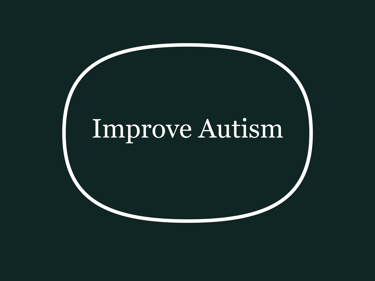A Ketogenic Diet and the Treatment of Autism Spectrum Disorder
Authors:
Li, Q., Liang, J., Fu, N., Han, Y. and Qin, J.
Conclusion:
The ketogenic diet shows potential as a treatment for ASD, improving social communication, reducing repetitive behaviors, and alleviating comorbidities like epilepsy and GI issues, as evidenced by small studies reviewed in the article. Benefits stem from enhanced energy metabolism, reduced inflammation, neurotransmitter balance, mTOR inhibition, and gut microbiota modulation, observed over 3 to 16 months. The diet typically consists of high fat (60-90%), low carbohydrates (<10%), and adequate protein (10-20%), sometimes modified with MCTs or other adjustments. However, larger, longer-term studies are needed to solidify these findings and assess the KD’s full safety profile for ASD management.
Key Findings:
Behavioral Improvements: Small studies (ranging from 1 to 45 participants) reported that a KD improved social communication, sociability, and reduced repetitive behaviors in some individuals with ASD. For example, one study with 45 children aged 3-8 years showed enhanced scores on the Autism Treatment Evaluation Test (ATEC) and Childhood Autism Rating Scale (CARS), particularly in sociability, after 6 months on a KD.
Comorbidity Relief: The KD was notably effective in alleviating comorbidities. Studies showed reductions in seizure frequency (e.g., in a child with autism and epilepsy after 14 months), ADHD symptoms, compulsive behaviors, and sleep disturbances. A study of six ASD patients with elevated beta-hydroxybutyrate levels reported improvements in social communication and reductions in multiple comorbidities after KD treatment.
Neuroprotective Mechanisms: The review proposes that the KD’s benefits stem from:
Enhancing brain energy metabolism by providing ketone bodies as an alternative fuel source.
Reducing inflammation and oxidative stress, which are elevated in ASD.
Balancing neurotransmitters like GABA and glutamate, often disrupted in ASD.
Inhibiting the overactive mTOR signaling pathway, linked to ASD behaviors.
Modulating gut microbiota, potentially improving GI symptoms and influencing brain function via the microbiota-gut-brain axis.
Safety and Side Effects: The KD is generally considered safe but can cause short-term side effects like constipation, vomiting, lack of energy, and hunger, especially in children. Long-term risks include hyperuricemia, hyperlipidemia, kidney stones, and possible height deceleration, though these are rare.
The article concludes that while the KD is a promising intervention, the evidence is limited by small sample sizes and short study durations (3-16 months), necessitating larger, more rigorous trials to confirm its efficacy and safety.
How the Ketogenic Diet Benefited People with Autism
The ketogenic diet benefited individuals with ASD by addressing both core symptoms (e.g., social deficits, repetitive behaviors) and comorbidities through several neuroprotective mechanisms:
Improved Energy Metabolism: Many individuals with ASD have impaired mitochondrial function, leading to inefficient brain energy production. The KD shifts the body to use ketone bodies (e.g., beta-hydroxybutyrate) instead of glucose, which cross the blood-brain barrier to fuel the brain, enhancing ATP production and normalizing mitochondrial function. This may improve cognitive and behavioral outcomes.
Anti-inflammatory and Antioxidative Effects:
ASD is linked to heightened neuroinflammation and oxidative stress. The KD reduces inflammation by activating pathways like PPARγ and lowers reactive oxygen species (ROS), protecting neurons and potentially reducing symptom severity.
Neurotransmitter Regulation: The diet increases GABA (an inhibitory neurotransmitter) and decreases glutamate (an excitatory one), correcting imbalances common in ASD. This stabilization can reduce seizures and improve behavioral regulation.
mTOR Pathway Inhibition: Overactivation of the mTOR pathway, involved in cell growth and synaptic function, is implicated in ASD. The KD inhibits this pathway, which may correct ASD-like behaviors, as seen in animal models and some human cases.
Gut Microbiota Modulation: GI issues, prevalent in 23-70% of ASD individuals, correlate with symptom severity. The KD alters gut microbiota composition (e.g., increasing Akkermansia and Parabacteroides in animal models), potentially improving GI health and influencing brain function through the microbiota-gut-brain axis, thus reducing behavioral symptoms.
These mechanisms collectively led to observed improvements, such as better social interactions and fewer seizures, in the reviewed studies.
Duration of the Diet and Observed Benefits
The duration of the ketogenic diet in the studies ranged from 3 to 16 months, with benefits observed within these periods:
Short-term (3-6 months): A study with 15 children aged 2-17 years on a modified KD with medium-chain triglycerides (MCTs) for 3 months showed improved social affect and autism diagnostic observation schedule (ADOS-2) scores. Another with 45 children aged 3-8 years reported enhanced sociability and CARS scores after 6 months.
Longer-term (6-16 months): A child with autism and epilepsy showed behavioral improvements and reduced seizures after 14 months on a KD following a gluten-free, casein-free diet. A 6-year-old on a KD for 16 months exhibited similar gains, while 30 children aged 4-10 years showed significant CARS score improvements after 6 months.
The article does not specify exact timelines for when benefits first appeared, suggesting variability based on individual factors and targeted symptoms. Some effects, like seizure reduction, might emerge relatively quickly, while behavioral improvements could take longer.
Composition of the Ketogenic Diet
The ketogenic diet used in these studies was characterized by:
High Fat: Typically 60-90% of total caloric intake, providing the primary energy source through ketosis.
Low Carbohydrates: Less than 10% of calories, often restricted to 20-50 grams daily, to minimize glucose use.
Adequate Protein: Around 10-20% of calories, sufficient for growth and maintenance without disrupting ketosis.
Variations included:
Modified Atkins Diet (MAD): A less strict KD with more protein and fewer carbohydrate limits, used in one study with a developmentally disabled man for 1 year.
MCT Supplementation: Some studies added medium-chain triglycerides, fats that rapidly convert to ketones, enhancing ketosis efficiency (e.g., in the 15-child study).
Gluten-Free, Casein-Free Prelude: One case started with this diet before transitioning to a KD, possibly to address dietary sensitivities common in ASD.
The diet’s composition was tailored in some instances to individual needs, but the core principle remained a high-fat, low-carb framework to induce ketosis.
https://pubmed.ncbi.nlm.nih.gov/34046374/
doi: 10.3389/fped.2021.650624


